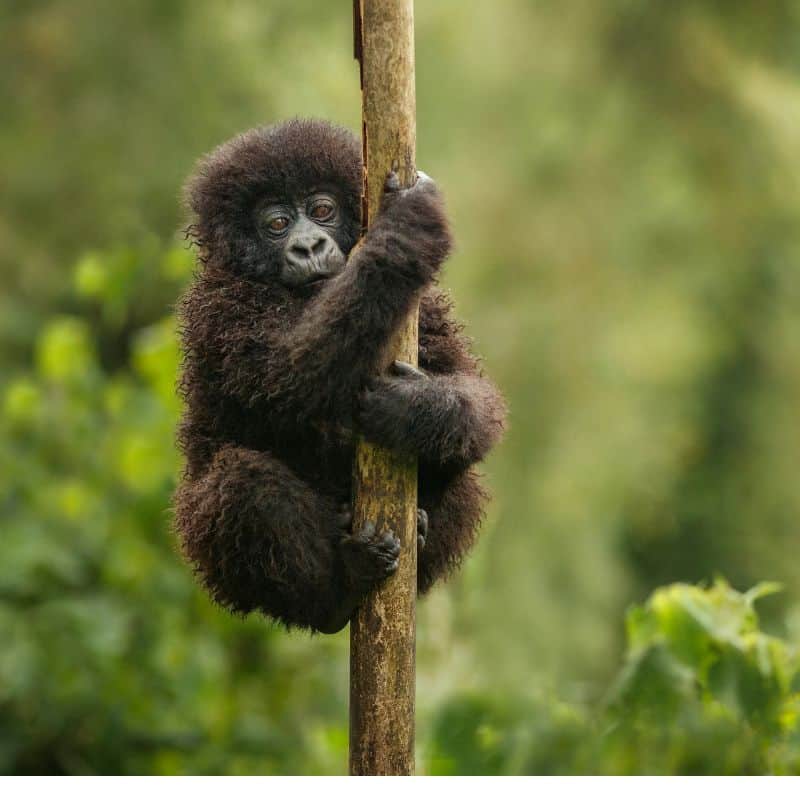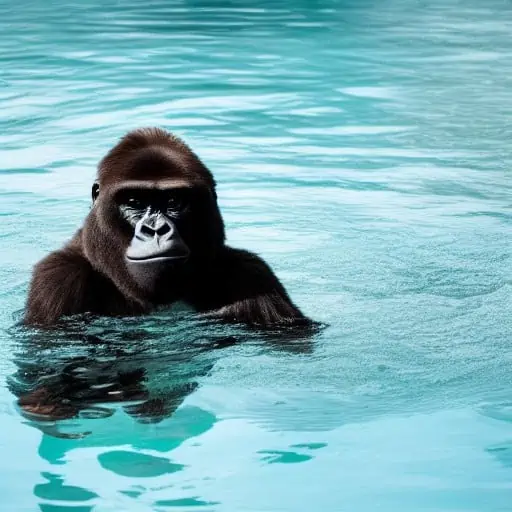Gorillas are some of the most imposing animals on the planet, but you rarely see them around water, so can gorillas swim?
Under normal circumstances, gorillas can’t swim. When they are adolescents, they will play and frolic in shallow water, but they won’t swim in it. People have observed gorillas in the wild taking sticks and sticking them in the water to see how deep they are before they cross or play in it.
The great apes are some of the most intelligent land mammals, and you would have thought they could swim, but then again, most humans also need to learn how to swim before they start swimming laps.

Can gorillas swim?
Like humans and other great apes, gorillas can’t swim naturally. They avoid large bodies of water like deep lakes and rivers.
Young gorillas have been observed splashing and playing in the rain and puddles of water but rarely go willingly into deep water.
If there is an unexpected rainstorm, gorillas will look for nearby caves or some shelter. If they don’t find any, they will sit perfectly still until the storm has passed.
Other apes like the bonobo and orangutans use big leaves to cover themselves, so they don’t get too wet. Still, no one has ever seen gorillas doing the same.
If a rainstorm has caused the water to rise quickly and the gorillas need to move, they will take a long stick and put it in the water to test the depth.
If it is not deeper than their waist, they will wade through the water with their arms in the air.
If the water is too deep, the gorillas will walk until they find a shallow section or another path.
Gorillas will drown if they are in water too deep for them to walk through; if the water is higher than their waists, they won’t go through it as they know the danger it poses.
So why can’t gorillas swim?
Biologists that have been studying the great apes have found that there are many reasons gorillas can’t swim. Some of these reasons include:
A gorilla’s body is not built for swimming
Other great apes (and humans) have fat in their bodies, making swimming easier. Fat is lighter than water, so humans and other great apes can float on water.
Gorillas are built differently; they are muscular and dense animals weighing 150 – 374 lb (68 – 170 kg), with some extreme specimens even weighing in at 500 pounds (227 kg).
That excludes fat because gorillas don’t have fat like humans and other great apes. That makes it extremely difficult for them to swim because muscle weighs more than water.
If circumstances forced a gorilla to swim (if it fell in the water, for example), it would sink, not float.
Their muscles are too heavy, so they lack the buoyance to keep them floating on the water.
Gorillas lack some motor skills
If you have seen gorillas on the TV or at the zoo playing, running, or walking, you might have noticed that they don’t move exactly in a graceful fashion. They lack some gross and fine motor skills.
Gross motor skills involve large muscle movements like independent crawling, sitting, walking, or running. Gorillas only develop what they need to survive.
Fine motor skills are the skills that involve finer muscles, like grabbing objects and holding things firmly or delicately.
Gorillas don’t have the gross motor skills to simultaneously move their arms and legs to help them glide through the water.
Likewise, they don’t have the fine motor skills to flatten their hands to swim effectively.
Their hands, arms, and legs are not used to bending as they would need to swim, and they can’t make the right movements to help them swim.
For example, researchers have observed orangutans and chimpanzees who can learn to swim using frog motions to carry them through the water. These great apes can be taught to swim because they have a fat layer that gives them enough buoyance to float.
Are gorillas afraid of water?
Gorillas are cautious of water because they don’t like to get wet. They instinctively fear drowning and that there might be a predator lurking in the depths of the water.
It is a natural protective instinct that many animals have.
Gorillas typically live in tropical areas, so there are many predators to look out for, including the water where crocodiles live.
As we know, predators like the crocodile won’t hesitate to attack anything that moves, including young gorillas.

Can gorillas be taught to swim?
Like all other great apes, gorillas are highly intelligent and can learn many skills that help them survive in their environment, but does that mean they can be taught to swim? While they are smart enough to learn the skill, their physical limitations mean they will never be able to use it.
Instead, their bodies have adapted to get across the water without ever needing to touch it.
They are cautious of water, and their body lacks the buoyancy they would need to float.
Floating is imperative if gorillas should ever try to swim. Floating keeps you above the water so your body is not dragged down. Gorillas cannot float, so their weight and muscles will drag their bodies under the water, and it won’t matter if they have been taught how to move through it.
They might stay above the water for a while using the right movements, but as soon as their bodies become tired, they will be pulled underwater and likely drown.
Can any of the great apes swim?
Most great apes keep away from the water for the same reasons as gorillas. However, all great apes have to learn to swim, as it doesn’t come naturally for them as it does for most animals. Some monkeys like to swim, but overall that is not the case.
Recently in a zoo in South Carolina, the zoo keepers were able to teach an orangutang named Suryia to swim.
She now loves the water and has shed her fear of it now that she knows how to navigate it better.
The second case of a great ape being taught to swim is Cooper, the chimpanzee that was part of a study to find out if chimpanzees could swim if they were taught.
The researchers stretched two ropes over the deepest parts of the pool to keep the chimpanzee from drowning.
That seemed to do the trick as, not long after the ropes were in place, Cooper waded into the water. They found out it was because he was curious about the ropes.
Cooper swam up to the ropes using frog strokes to take a closer look and has been swimming ever since.
Once Cooper and Suryia understood they could swim and learned how to, they lost their fear of the water.
The researchers also think their anxiety might have lessened because the water is clear, and you can see to the bottom, so they don’t need to worry about lurking predators.
Final thoughts on gorillas swimming
Gorillas are one of the toughest animals on the planet, but they’re not very fond of swimming. While some animals are born with the skill to swim, gorillas, like humans and other great apes, are not that lucky.
Their bodies are incapable of swimming because they don’t have the right motor skills and buoyance needed to swim.
Furthermore, they rarely need to cross water, so there is no real need for them to learn how.
The only time you might see a gorilla swimming is if someone is dressed up in a gorilla costume…


